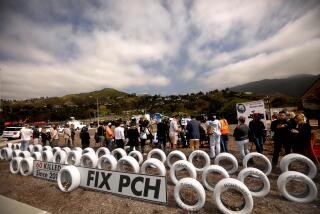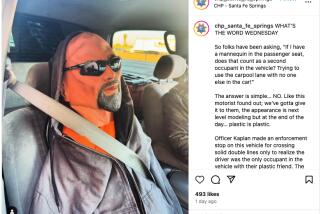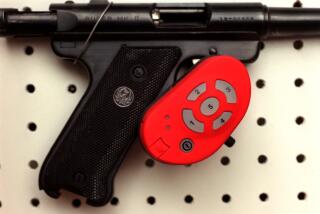Checkpoint Stresses Use of Infant Car Seats
- Share via
Two grandmothers and a father were among the drivers who learned lessons in child car safety Wednesday after being nabbed at a police checkpoint designed to catch motorists who did not have their children properly buckled up.
No one was arrested or cited at the checkpoint held from 10 a.m. to noon on the eastbound lanes of 3rd Street at Vermont Avenue, just west of downtown Los Angeles. Instead of tickets carrying up to a $250 fine, offenders were given free car seats.
All were grateful and some were red-faced.
“I was just taking the child to McDonald’s for breakfast,” said Alita Murray, who had her 3-year-old granddaughter buckled up in the front passenger seat. She should have buckled her into a child car seat that was buckled to the rear passenger seats.
“I forgot to get the car seat from her mother,” Murray said. “But I guess even a short trip can be dangerous.”
Traffic accidents are the leading cause of death for children 5 to 14 years old, according to the National Highway Traffic Safety Administration. In 1995, 616 children under 5 died in crashes; 350 of the victims were unrestrained.
As her boyfriend Juan Lopez drove through the checkpoint, Alma Chavez, 25, had taken their year-old daughter Stephanie out of the child seat for a moment as the baby awoke from a nap.
When she was pulled over, Chavez had the proper car seat but said she could not resist taking the fussy baby out and holding her. After all, it was the girl’s first birthday.
“I should leave her in the car seat no matter what,” Chavez said. “I’m glad the officers pulled us over to remind us of that.”
The effort was part of Operation ABC, a weeklong national campaign endorsed by President Clinton and backed by auto makers, the insurance industry, child car seat manufacturers and law enforcement agencies.
In California, the Los Angeles Police Department will conduct at least three checkpoints throughout the city. The California Highway Patrol will make 10,000 child safety seats available at 125 community health centers.
The campaign is designed to cut air-bag-related deaths that have claimed 35 children and 20 adults nationwide, according to the traffic safety agency. Most of the victims lacked proper restraints or were in the more dangerous front seat of the vehicle when the air bags deployed in their face or upper body, Operation ABC organizers said.
The deaths have caused many consumers to question the safety of air bags, once an aggressively marketed extra that has also been credited with saving 500 people in 1996.
In November, federal highway safety regulators required auto makers to put safety labels in cars with air bags, alerting buyers to potential dangers. Officials also unveiled a proposal allowing auto makers to reduce the force at which the bags deploy.
“I don’t think anyone thinks we should do away with air bags,” said Janet Dewey, a spokeswoman for the ABC campaign. “People just want to know how we should make them perform better.”
Dewey said the air bag safety effort also makes good business sense for the manufacturers and insurers. It would cost an estimated $40 per car to meet a federal regulatory proposal that would require “smart” air bags in cars by 1999. Devices would sense the weight and position of a passenger and activate at a safe speed based on those measurements.
(BEGIN TEXT OF INFOBOX / INFOGRAPHIC)
Car Safety for Children
Some guidelines for having children ride safely:
* Children 12 and under should ride buckled up in a rear seat.
* Infants in rear-facing child safety seats should never ride in the front seat of a vehicle with a passenger-side air bag.
* Small children should ride in a rear seat in child safety seats approved for their age and size.
* Drivers should check the vehicle and child car seat owner’s manuals for correct use information.
More to Read
Sign up for Essential California
The most important California stories and recommendations in your inbox every morning.
You may occasionally receive promotional content from the Los Angeles Times.










